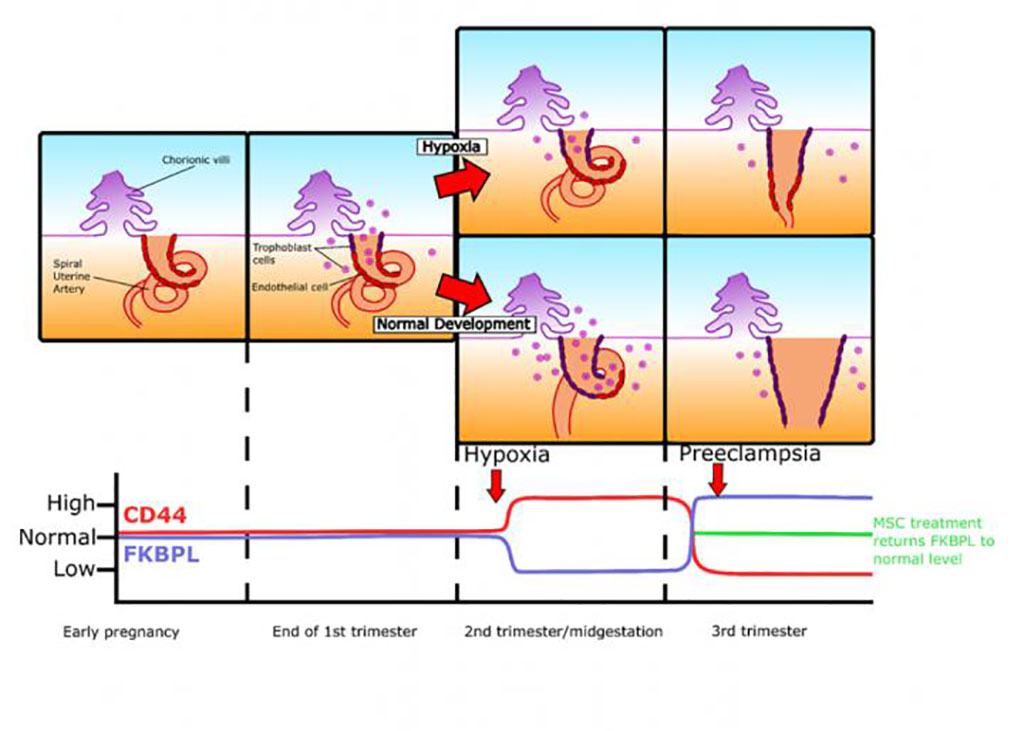Elevated Levels of Two Protein Biomarkers Indicate Potential for Development of Pre-Eclampsia
By LabMedica International staff writers
Posted on 16 Jul 2020
A pair of novel protein biomarkers has been identified in the blood of asymptomatic pregnant women that can be used to predict the potential onset of pre-eclampsia.Posted on 16 Jul 2020
Pre-eclampsia (PE) is a disorder of pregnancy characterized by the onset of high blood pressure and often a significant amount of protein in the urine. When it arises, the condition begins after 20 weeks of pregnancy. In severe disease there may be red blood cell breakdown, a low blood platelet count, impaired liver function, kidney dysfunction, swelling, shortness of breath due to fluid in the lungs, or visual disturbances. Pre-eclampsia increases the risk of poor outcomes for both the mother and the baby. If left untreated, it may result in seizures at which point it is known as eclampsia. Ten to 15% of maternal mortality is associated with pre-eclampsia and eclampsia.

Image: Summary of changes FKBPL and CD44 changes throughout gestation in pregnancies complicated by pre-eclampsia (Photo courtesy of Oxford Press)
Development of effective prevention and treatment strategies for pre-eclampsia has been limited by the lack of accurate methods for identification of at-risk pregnancies.
In an effort to correct this lack, investigators at the University of Technology Sydney (Australia) evaluated the diagnostic and therapeutic potential for pre-eclampsia of the angiogenesis protein markers, FKBPL-CD44. FKBPL (FKBP prolyl isomerase like) has similarity to the immunophilin protein family, which play a role in immunoregulation and basic cellular processes involving protein folding and trafficking. CD44 is a cell-surface glycoprotein involved in cell-cell interactions, cell adhesion, and migration. It is a receptor for hyaluronic acid (HA) and can also interact with other ligands, such as osteopontin, collagens, and matrix metalloproteinases (MMPs). This protein participates in a wide variety of cellular functions including lymphocyte activation, recirculation and homing, hematopoiesis, and tumor metastasis.
For the current study, the investigators analyzed 57 samples that were pre-diagnosis (15 and 20 weeks’ gestation) and 18 that were post-diagnosis (14 for plasma; four for placenta) of pre-eclampsia for determination of FKBPL and CD44 concentrations, compared to healthy controls.
Results revealed that the CD44/FKBPL ratio was reduced in placenta and plasma following clinical diagnosis of pre-eclampsia. At 20 weeks’ gestation, a high plasma CD44/FKBPL ratio was independently associated with the 2.5-fold increased risk of pre-eclampsia.
"There are two main types of pre-eclampsia: early-onset pre-eclampsia diagnosed before 34 weeks of a pregnancy and late-onset pre-eclampsia diagnosed from 34 weeks onwards," said senior author Dr. Lana McClements, lecturer in biotechnology at the University of Technology Sydney. "The vast majority of the current screening and monitoring strategies are focused on early-onset pre-eclampsia, which comprises only 10-15% of all pre-eclampsia cases, whereas late pre-eclampsia has been largely neglected."
"The biomarkers allow the prediction of irregular placenta or maternal vascular function, which are key underlying causes of pre-eclampsia," said Dr. McClements. "This could lead to the early diagnosis and prevention of severe pre-eclampsia and associated complications including death, therefore also giving insight into disease mechanisms and possible treatment targets."
The study was published in the July 3, 2020, online edition of the Journal of Clinical Endocrinology and Metabolism.
Related Links:
University of Technology Sydney














